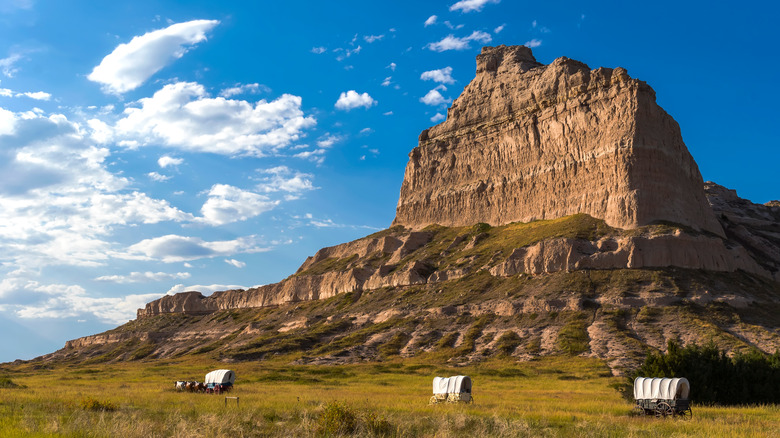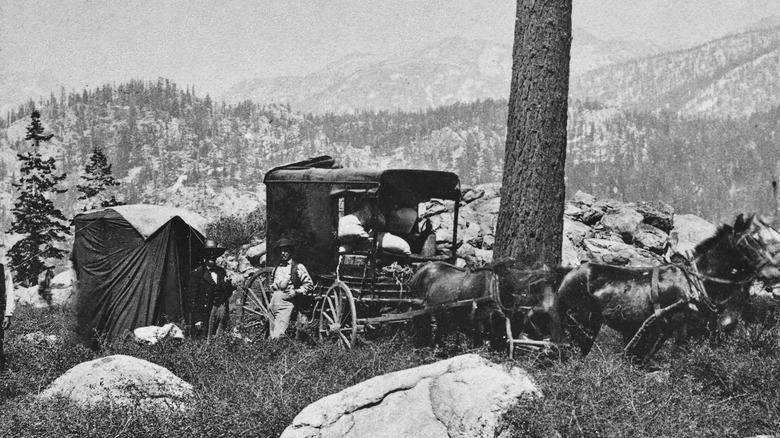The Estimated Number Of Deaths On The Oregon Trail Is Probably More Than You Think
Who would have thought that a 1990 video game about carting through the uncharted west in a caravan of covered wagons, oxen, disease, death, and rifles would have become such a hit? Granted, the video game didn't get everything quite right, especially the leisurely leg-dangling in pools of fresh water. But there's something about the Wild West, with its largely (even totally) inaccurate vision of freedom — wandering on horseback towards sunsets, reveling in American rugged heroic individualism, and so forth — that's made the era stick in the memory and be romanticized in countless TV shows, movies, and of course, games like "Oregon Trail."
The real Oregon Trail, though, was the absolute pits. Legends of America recounts the advice that once anonymous settler had for anyone who wanted to join the approximately 350,000 who made the journey from Illinois to Oregon from the 1830s through the 1860s: "He must learn to eat with his unwashed fingers, drink out of the same vessel as his mules, sleep on the ground when it rains, share his blanket with vermin, and have patience with mosquitos." This settler might not have precisely known that 10 to 15 people died every mile on the trail, or that roughly 20,000 total would die, per History. But if he made it all the way to the shores of Oregon, it would be interesting to know what he'd think of his descendants in the land of vegans and bicycles that is now Portland.
Diseases aplenty
Here's a question for you: If you knew that you had a five percent chance of dying on a flight from Chicago's O'Hare to Portland's PDX, would you bother to pack a carry-on? And we're not talking about death from the sterility of airplane air, cardboard-flavored airplane food, or the dingy fabric of well-worn airplane seats. We're also not talking about death by plane crash — although that might be preferable. We're talking about death via a host of festering diseases.
There's a laundry list of all the various diseases that slaughtered people on the Oregon Trail. There's cholera, which kills you through diarrheal dehydration. Then there's respiratory diphtheria, in which the airways in the nose and throat can become covered in a "thick, gray coating" of "dead tissue" per the CDC. There's also dysentery, which causes (again) death by diarrhea, except this time it's bloody. We've also got typhoid fever, which devours the intestines. Measles, meanwhile, is manageable in the modern day, but without antibiotics in the middle of the dusty, dirty, waterless waste-bowl of the West? No.
Practically all of these diseases come from unclean water, which if you recall from the anonymous settler's advice wasn't in too great of a supply while embarking on the world's worst one-way road trip. 1990's "Oregon Trail" got this part all wrong. Lack of clean, fresh water plus constant contact with unwashed family and strangers, the companionship of equally unwashed animals pulling carts ... yeah, say goodbye to life.
Run-ins with locals
Besides all the diarrheal death, fevers, lack of flushable toilets, dearth of clean drinking water, and hot sun that bakes flesh and encourages bacterial growth, there's another death method that took out a number of settlers traveling the Oregon Trail: run-ins with Native Americans. Granted, 362 deaths out of 20,000 total isn't too high of a percentage. And, as the Oregon Trail Center cites, settlers killed 426 of them. Plus, the natives were there first.
The Oregon Trail Center says that native tribes — Sioux, Crow, Kiowa, Shoshone, and more — generally didn't have a problem with folks passing through their land. Most encounters ended peacefully, with settlers trading knives, food, etc., for goods like robes and moccasins. That being said, theft was a problem now and then. Tribespeople usually stole food, and if travelers were sojourning by themselves, they'd be much more likely to be targeted. The majority of violent conflicts tended to crop up along the western parts of the trail, like the Humboldt River in Nevada, or the Applegate Trail that leads to the Willamette Valley in Oregon. The vast majority of those killed by Native Americans — an estimated 90% — were killed along this "South Pass," largely from the 1840s through the '60s.
But regardless of cause, you might be thinking, "Hey, if I die I'll at least get a respectful burial, right?" No, you'd probably just get rolled over by wagon wheels, intentionally, to help minimize the appeal your corpse presented to scavengers or wolves, per the Oregon Trail Center.


